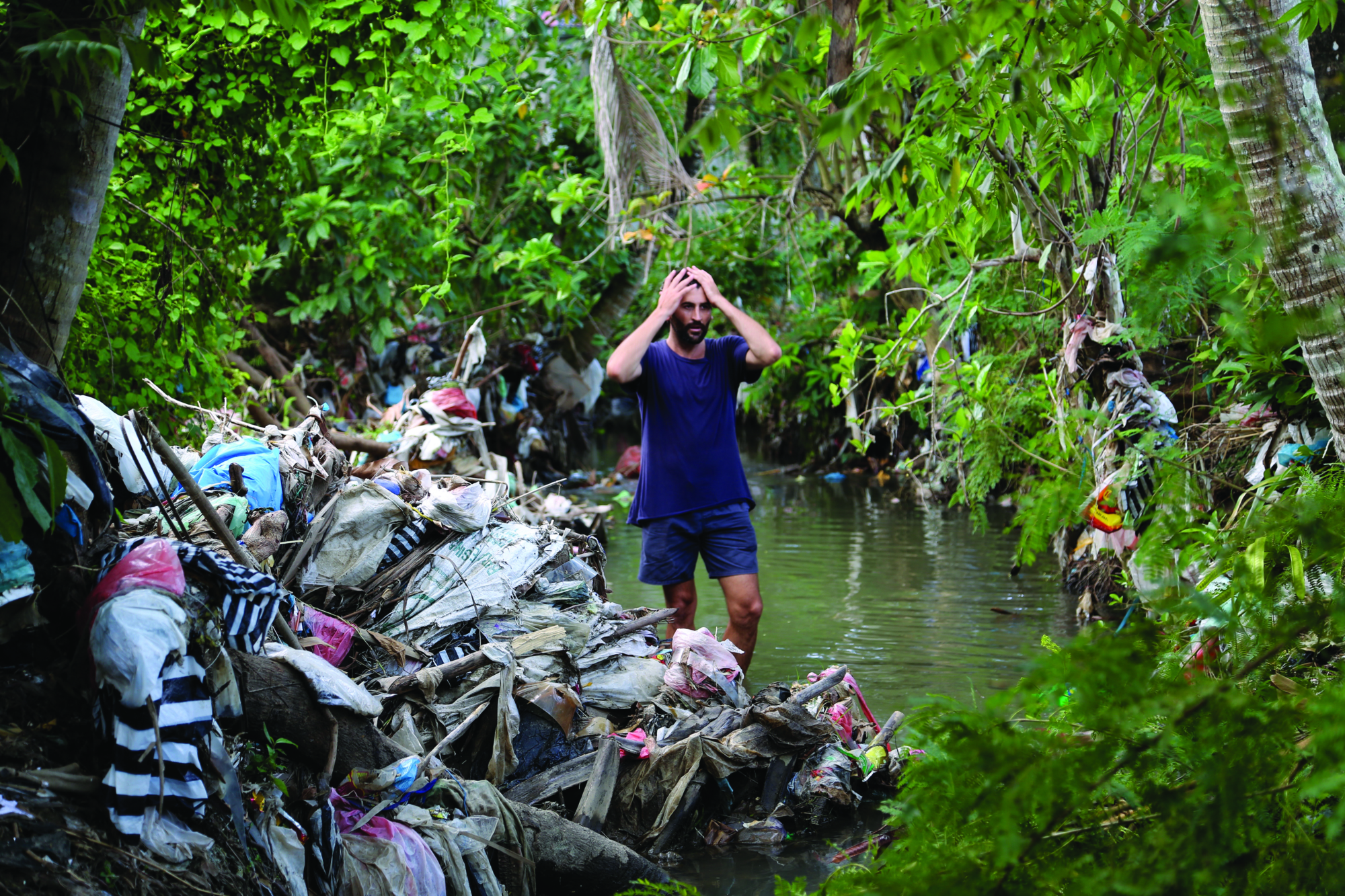In Blue (2017), writer/director Karina Holden asks the audience to dive into the ocean and witness firsthand the way humanity has allowed our most valuable resource to come to the brink of irreversible destruction. It’s a tough film, yet one with the message that, hopefully, not all is lost.
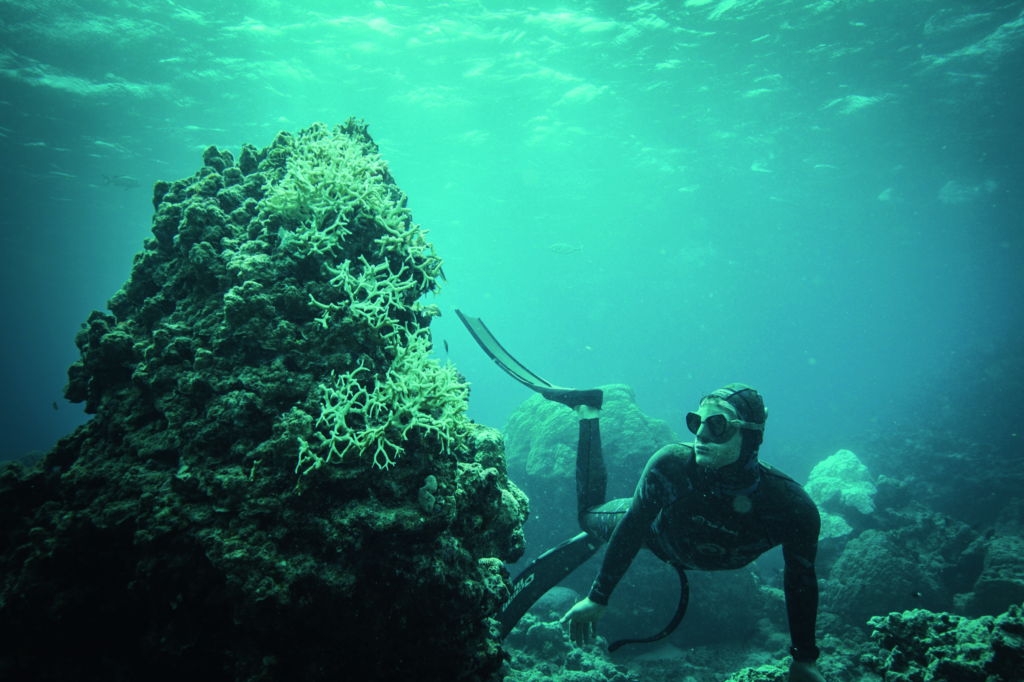
Known predominantly for her directing work on nature documentaries and for having produced the factual programs Luke Warm Sex and Changing Minds: The Inside Story, Holden shows adeptness at marrying the classic nature-documentary style of Jacques Cousteau and David Attenborough with the politically charged ‘enviro-doc’ trend of recent years.[1]See Oakley Anderson-Moore, ‘16 Films That Prove 2017 Was the Year of Epic Enviro-docs’, No Film School, 15 December 2017, <https://nofilmschool.com/2017/12/2017-year-of-epic-environmental-documentaries>, accessed 22 February 2018. Blue is the kind of film that dazzles with beautiful imagery of a sea turtle swimming peacefully among the reef before confronting viewers with footage of men clearing Cape York’s pristine white sands of decaying turtle skeletons, which have washed ashore in a tangled mess of fishing nets and shipping wires. Blue is replete with arresting visuals – shark bodies sinking to the bottom of the sea after having their fins hacked off; seals caught in fishing nets; seabirds that nest far away from mass civilisation, whose stomachs have to be pumped as they are full of plastic debris that has travelled halfway around the world.
Recognising that viewers are likely to mentally turn off when faced with an endless parade of atrocities, Holden opted to steer clear of simple hand-wringing and ensure that ‘the aesthetics of the film [would] be captivating’. As she puts it:
I wanted there to be beauty in the imagery, despite the subject. For words to be soothing, notwithstanding their weight. For the music to be understated, regardless of the drama. This allows the audience to discover their own emotions about what they are seeing, without leading them.[2]Karina Holden, ‘Directors Statement’, in Transmission Films, Blue press kit, 2017, p. 7.
It is this stylistic decision that has allowed Holden’s film to effectively tackle the many issues facing the Earth’s oceans, including overfishing, water pollution and climate change–induced coral bleaching. This is a vital part of what makes Blue stand out among the sea of enviro-docs from around the world.
Recognising that viewers are likely to mentally turn off when faced with an endless parade of atrocities, Holden opted to steer clear of simple hand-wringing and ensure that ‘the aesthetics of the film [would] be captivating’.
The enviro-doc today
For all of its virtues, Blue holds a curious place in both the local and international documentary scenes. It’s no secret that the number of documentaries produced every year is growing, thanks to advances in technology as well as evolutions in theatrical and streaming-based distribution models. In October last year, for example, the Academy of Motion Picture Arts and Sciences announced a record-breaking 170 submissions to the Oscars’ Best Documentary category.[3]Steve Pond, ‘170 Films Enter Oscars Documentary Category, Setting New Record’, The Wrap, 27 October 2017, <https://www.thewrap.com/170-films-qualify-oscars-documentary-category-setting-new-record/>, accessed 22 February 2018. And that list doesn’t include the hundreds – potentially thousands – more produced that year that didn’t secure an American distributor.
Premiering at the 2017 Sydney Film Festival, Blue had a subsequent theatrical release that was met with mostly empty seats, averaging less than A$1,000 per cinema over its opening weekend in October 2017.[4]Don Groves, ‘BO Report: Ticket Sales Slump Despite The Mountain Between Us, Happy Death Day and New Oz Releases’, IF.com.au, 16 October 2017, <https://www.if.com.au/bo-report-ticket-sales-slump-despite-mountain-us-happy-death-day-new-oz-releases/>, accessed 22 February 2018. It’s impossible to deny that the film struggled to connect with viewers who, as Kristian Connelly of Melbourne’s Cinema Nova suggests, are likely burnt out by doomsday documentaries that offer little beyond hopelessness at our fate. ‘Few audiences want to be told that the ocean is dying,’ he explains, ‘only to learn that the Adani coal mine is being put ahead of the protection of the Great Barrier Reef.’[5]Kristian Connelly, quoted in Don Groves, ‘Australian Films BO Scorecard November 2017: The Year’s Hits and Misses’, IF.com.au, 1 December 2017, <https://www.if.com.au/australian-films-bo-scorecard-november-2017-years-hits-misses/>, accessed 22 February 2018.
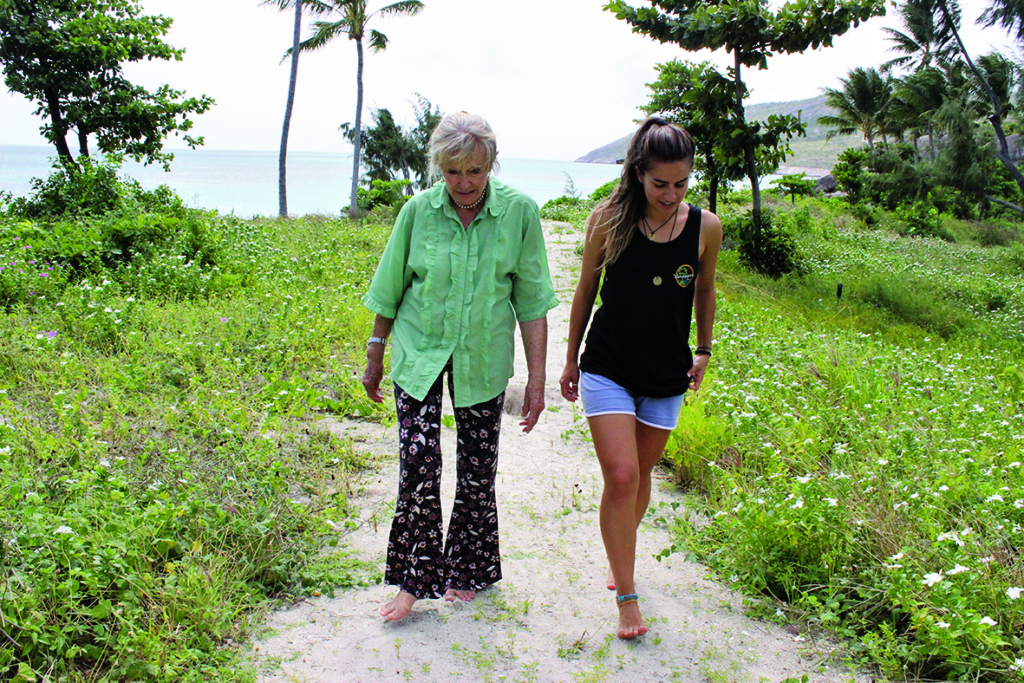
Documentaries expounding on the environment are not rare, of course; the form has always been a popular method of getting the message of environmental conservation out to wide audiences. In Australia, the genre goes back to The Reef (John Heyer, 1978), which – within the bounds of my research – was the first major local release to raise the issue of climate change and its effect on coral reefs. More recent examples include Frackman (Richard Todd, 2015) and Aim High in Creation! (Anna Broinowski, 2013), both of which tackle the coal-seam-gas industry albeit in wildly different and entertaining ways. Meanwhile, Kangaroo (Kate McIntyre Clere & Michael McIntyre, 2017) seeks to highlight Australia’s barbaric history of and continued reliance on the culling and inhumane slaughter of the titular animals.
Even more so in the US, where independent filmmakers can access an abundance of non-government funding avenues, enviro-docs are becoming predominantly niche festival and video-on-demand titles. Several have been able to push through into the mainstream, such as Blackfish (Gabriela Cowperthwaite, 2013), The Cove (Louie Psihoyos, 2009) and, most famously, An Inconvenient Truth (Davis Guggenheim, 2006). However, the dramatic downturn in box-office gross between Guggenheim’s Oscar winner – the third-highest-grossing documentary of all time in the US at the time of its release[6]Steve Gorman, ‘Gore’s Inconvenient Truth Wins Documentary Oscar’, Reuters, 26 February 2007, <https://www.reuters.com/article/us-oscars-gore1/gores-inconvenient-truth-wins-documentary-oscar-idUSN2522150720070226>, accessed 22 February 2018. – and its successor, An Inconvenient Sequel: Truth to Power (Bonni Cohen & Jon Shenk, 2017),[7]Ted Johnson, ‘Inconvenient Sequel Didn’t Match Original’s Big Debut, but It’s Not a “Bomb,” Either’, Variety, 8 August 2017, <http://variety.com/2017/film/news/al-gore-inconvenient-sequel-paramount-box-office-1202519036/>, accessed 22 February 2018. suggests that the enviro-doc bubble may have burst. More recent films – such as Deep Time (Noah Hutton, 2015), What Lies Upstream (Cullen Hoback, 2017) and Rancher, Farmer, Fisherman (Susan Froemke & John Hoffman, 2017) – have had quiet home-entertainment releases preceded by very limited theatrical releases (if at all).
One of Holden’s strongest messages throughout Blue is that, while we as a society are indeed past the tipping point wherein an ecological panacea cannot exist, there is much that can still be done.
Significantly, the only environment-themed documentary that I have noticed making a genuine cultural impact in recent times is Chasing Coral (Jeff Orlowski, 2017) – which, it’s worth noting, landed directly on Netflix after its festival run. Not only did the film’s easy availability mean that it could be seen immediately by anybody who wanted to see it, but members of the media were also more readily able to cover it. Would Blue have attracted more mainstream attention had it gone out via streaming?
Personally, I’m glad I saw it on the big screen for the sheer beauty of the cinematography by Jody Muston and Jon Shaw, who deservedly won the 2017 AACTA Award for Best Cinematography in a Documentary. But I would have gotten more enjoyment from knowing that people had seen the film and were talking about it.
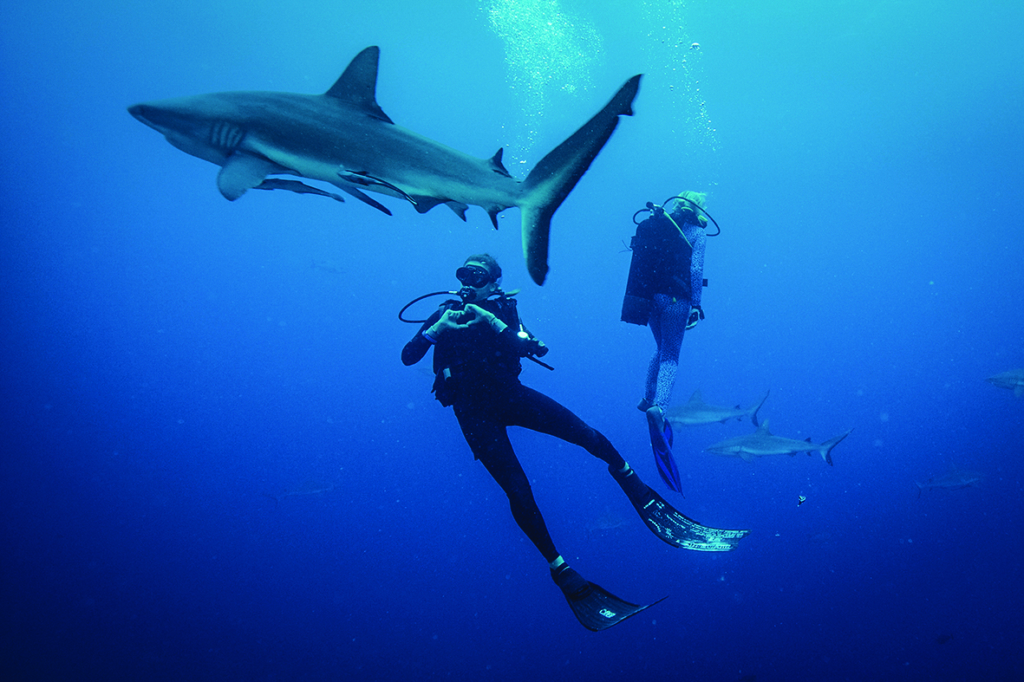
Making a splash
Today, there appears to be a growing sense of lethargy towards environmental issues. Whether that’s because our attempts at protest seem futile, or because of the sheer volume of action required to even begin reversing the damage done to our planet, it’s fair to assume that many are throwing their hands up in the air in resigned defeat (I often feel like this myself).
It’s telling that, in the US, many are oblivious to President Donald Trump’s plans to open up mainland coastal regions for offshore drilling[8]Brittany Patterson & Zack Colman, ‘Trump Opens Vast Waters to Offshore Drilling’, Scientific American, 5 January 2018, <https://www.scientificamerican.com/article/trump-opens-vast-waters-to-offshore-drilling/>, accessed 22 February 2018. after having previously slashed funding for initiatives protecting against marine and ecological disasters like oil spills.[9]Oliver Milman, ‘Trump Budget Would Gut EPA Programs Tackling Climate Change and Pollution’, The Guardian, 17 March 2017, <https://www.theguardian.com/environment/2017/mar/16/trump-budget-cuts-climate-change-clean-up-programs-epa>, accessed 22 February 2018. In Australia, there is some optimism as states continue to move towards a full eradication of plastic bags from supermarket check-outs.[10]Michael Dulaney, ‘Coles to Follow Woolworths’ Lead and Phase Out Plastic Bags Around the Country’, ABC News, 14 July 2017, <http://www.abc.net.au/news/2017-07-14/woolworths-to-phase-out-plastic-bags-around-the-country/8709336>, accessed 23 February 2018. But one only needs to look at the aforementioned Adani mine fracas,[11]Julien Vincent, ‘Adani’s Mega Mine: It’s Not Over Yet’, The Age, 9 January 2018, <https://www.theage.com.au/business/companies/adanis-mega-mine-its-not-over-yet-20180109-h0fh1q.html>, accessed 22 February 2018. or at debates around carbon pricing,[12]Stephanie Anderson, ‘Why Is Everyone Talking About a Carbon Tax? The Carbon Pricing Debate Explained’, ABC News, 7 December 2016, <http://www.abc.net.au/news/2016-12-05/the-carbon-pricing-debate-explained/8092506>, accessed 22 February 2018. shipping-port dredging,[13]Oliver Milman, ‘Great Barrier Reef Dredging Could Be More Damaging than Thought’, The Guardian, 15 August 2013, <https://www.theguardian.com/environment/2013/aug/15/dredging-report-queensland-barrier-reef>, accessed 22 February 2018. national-park mining[14]Peter Ker, ‘Uranium Mining in Kakadu at a Crucial Point’, The Age, 28 November 2014, <https://www.theage.com.au/business/companies/uranium-mining-in-kakadu-at-a-crucial-point-20141127-11vmr3.html>, accessed 22 February 2018. and (remarkably) even wind turbines,[15]Graham Readfearn, ‘Australia’s Wind Energy Debate Spinning out of Control’, The Guardian, 3 June 2013, <https://www.theguardian.com/environment/planet-oz/2013/jun/02/wind-turbine-power-health-australia>, accessed 22 February 2018. to see how many steps backwards the nation is taking for every single step forward we get on environmental issues.
To suggest that Blue (and others of its ilk) offers viewers no hope, however, is wrong. It’s true that the picture painted by the documentary is dire. But one of Holden’s strongest messages throughout Blue is that, while we as a society are indeed past the tipping point wherein an ecological panacea cannot exist, there is much that can still be done. Going beyond just sending viewers to relevant websites at its conclusion (as many other social-issues documentaries do), Blue highlights various measures that can be taken by the layperson. To accomplish this, it features ‘episodes’ dedicated to seven environmental crusaders – labelled #OceanGuardians in the film’s publicity materials – who each take on and educate about an issue relating to the preservation and protection of the sea. There’s Lucas Handley, a marine biologist and underwater photographer; Madison Stewart, aka ‘Shark Girl’, a conservation activist; Phillip Mango, a land and sea ranger; Jennifer Lavers, a marine eco-toxicologist with a focus on seabirds; Tim Silverwood, a sustainability advocate and environmental campaigner; Mark Dia, a Greenpeace campaigner; and Valerie Taylor, a famed 82-year-old activist who, among other things, has witnessed how the Great Barrier Reef changed in front of her very eyes. With her leopard-print scuba outfit and pink handbag full of fish bait – and her past work as a crew member on Jaws (Steven Spielberg, 1975) – Taylor, in particular, proves that there is no age limit when it comes to being environmentally conscious.
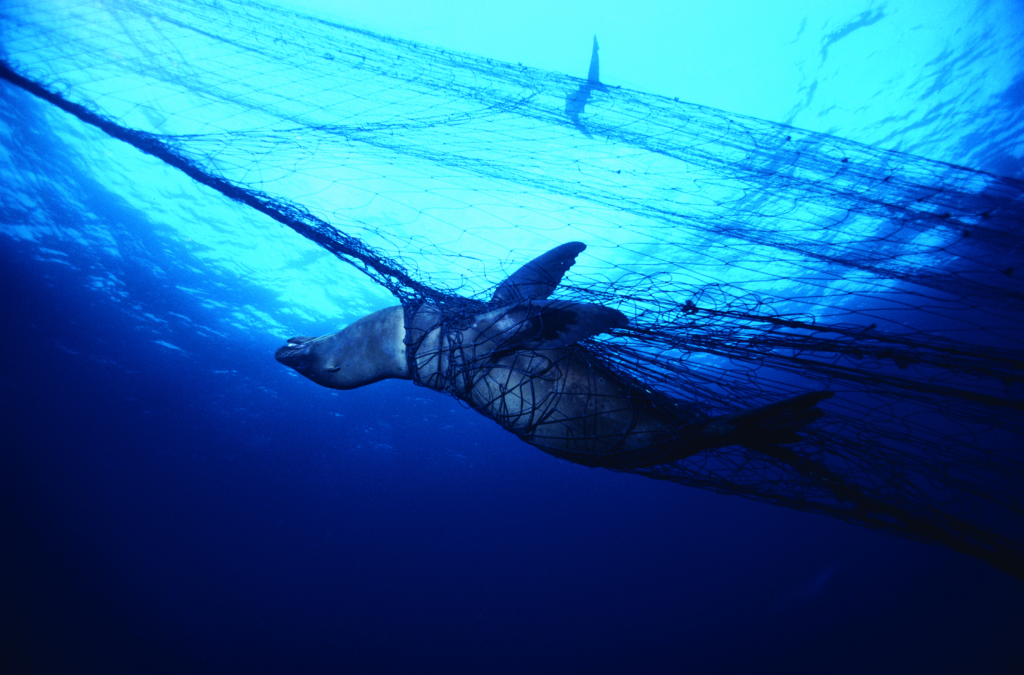
Through these #OceanGuardians, we learn a range of potential steps that can be taken to help the environment. It could be as simple as shopping for sustainable tuna at the supermarket or partaking in Silverwood’s ‘Take 3’ initiative, which asks people to ‘Take 3 pieces of rubbish with you when you leave the beach, waterway or … anywhere’.[16]See Take 3 website, <http://www.take3.org>, accessed 22 February 2018. And Blue’s activism doesn’t end on the big screen. The filmmakers are hoping it can find a home as an educational resource in schools and have released a collection of complementary readings for those interested in the cause. They have also outlined an extensive list of goals[17]The full list of goals is available at ‘Blue’, Documentary Australia Foundation website, <http://www.documentaryaustralia.com.au/films/2902/blue>, accessed 22 February 2018. that they hope to achieve not just through Blue, but also through wider campaigns of awareness and change spurred by the film.
Blue is a nourishing documentary, both intellectually and for the way it succeeds in hooking viewers – something that, I hope, will enable it to have a longer post-theatrical life as an educational resource. But, if films with the same level of ambition and technical prowess as Blue seek to remain valuable and influence national and international conversations, they need to have a substantive look at how and – increasingly more important – where they are telling their stories. Blue may have been particularly effective because its advocacy was enacted not with a battering ram, but with honest, multifaceted storytelling. Even despite that, though, it’s likely Holden’s film was preaching to the choir: I highly doubt that any of the six other people at my Sunday-morning session weren’t already doing their small, yet no-less-significant, bit for the environment.
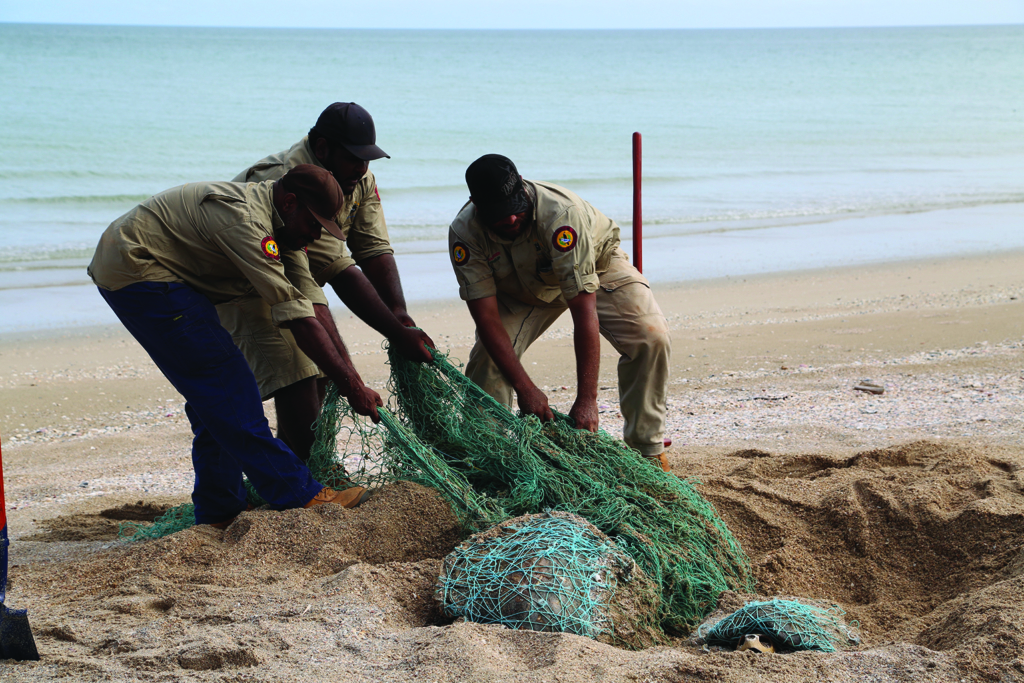
Imagine the change that could occur if more people saw Blue – particularly younger viewers, who may not have a full grasp on what happens when they throw something in the gutter on their way home from school. Just as we want society to change, filmmakers are no doubt going to have to change the way they make and market their work.
Endnotes
| 1 | See Oakley Anderson-Moore, ‘16 Films That Prove 2017 Was the Year of Epic Enviro-docs’, No Film School, 15 December 2017, <https://nofilmschool.com/2017/12/2017-year-of-epic-environmental-documentaries>, accessed 22 February 2018. |
|---|---|
| 2 | Karina Holden, ‘Directors Statement’, in Transmission Films, Blue press kit, 2017, p. 7. |
| 3 | Steve Pond, ‘170 Films Enter Oscars Documentary Category, Setting New Record’, The Wrap, 27 October 2017, <https://www.thewrap.com/170-films-qualify-oscars-documentary-category-setting-new-record/>, accessed 22 February 2018. |
| 4 | Don Groves, ‘BO Report: Ticket Sales Slump Despite The Mountain Between Us, Happy Death Day and New Oz Releases’, IF.com.au, 16 October 2017, <https://www.if.com.au/bo-report-ticket-sales-slump-despite-mountain-us-happy-death-day-new-oz-releases/>, accessed 22 February 2018. |
| 5 | Kristian Connelly, quoted in Don Groves, ‘Australian Films BO Scorecard November 2017: The Year’s Hits and Misses’, IF.com.au, 1 December 2017, <https://www.if.com.au/australian-films-bo-scorecard-november-2017-years-hits-misses/>, accessed 22 February 2018. |
| 6 | Steve Gorman, ‘Gore’s Inconvenient Truth Wins Documentary Oscar’, Reuters, 26 February 2007, <https://www.reuters.com/article/us-oscars-gore1/gores-inconvenient-truth-wins-documentary-oscar-idUSN2522150720070226>, accessed 22 February 2018. |
| 7 | Ted Johnson, ‘Inconvenient Sequel Didn’t Match Original’s Big Debut, but It’s Not a “Bomb,” Either’, Variety, 8 August 2017, <http://variety.com/2017/film/news/al-gore-inconvenient-sequel-paramount-box-office-1202519036/>, accessed 22 February 2018. |
| 8 | Brittany Patterson & Zack Colman, ‘Trump Opens Vast Waters to Offshore Drilling’, Scientific American, 5 January 2018, <https://www.scientificamerican.com/article/trump-opens-vast-waters-to-offshore-drilling/>, accessed 22 February 2018. |
| 9 | Oliver Milman, ‘Trump Budget Would Gut EPA Programs Tackling Climate Change and Pollution’, The Guardian, 17 March 2017, <https://www.theguardian.com/environment/2017/mar/16/trump-budget-cuts-climate-change-clean-up-programs-epa>, accessed 22 February 2018. |
| 10 | Michael Dulaney, ‘Coles to Follow Woolworths’ Lead and Phase Out Plastic Bags Around the Country’, ABC News, 14 July 2017, <http://www.abc.net.au/news/2017-07-14/woolworths-to-phase-out-plastic-bags-around-the-country/8709336>, accessed 23 February 2018. |
| 11 | Julien Vincent, ‘Adani’s Mega Mine: It’s Not Over Yet’, The Age, 9 January 2018, <https://www.theage.com.au/business/companies/adanis-mega-mine-its-not-over-yet-20180109-h0fh1q.html>, accessed 22 February 2018. |
| 12 | Stephanie Anderson, ‘Why Is Everyone Talking About a Carbon Tax? The Carbon Pricing Debate Explained’, ABC News, 7 December 2016, <http://www.abc.net.au/news/2016-12-05/the-carbon-pricing-debate-explained/8092506>, accessed 22 February 2018. |
| 13 | Oliver Milman, ‘Great Barrier Reef Dredging Could Be More Damaging than Thought’, The Guardian, 15 August 2013, <https://www.theguardian.com/environment/2013/aug/15/dredging-report-queensland-barrier-reef>, accessed 22 February 2018. |
| 14 | Peter Ker, ‘Uranium Mining in Kakadu at a Crucial Point’, The Age, 28 November 2014, <https://www.theage.com.au/business/companies/uranium-mining-in-kakadu-at-a-crucial-point-20141127-11vmr3.html>, accessed 22 February 2018. |
| 15 | Graham Readfearn, ‘Australia’s Wind Energy Debate Spinning out of Control’, The Guardian, 3 June 2013, <https://www.theguardian.com/environment/planet-oz/2013/jun/02/wind-turbine-power-health-australia>, accessed 22 February 2018. |
| 16 | See Take 3 website, <http://www.take3.org>, accessed 22 February 2018. |
| 17 | The full list of goals is available at ‘Blue’, Documentary Australia Foundation website, <http://www.documentaryaustralia.com.au/films/2902/blue>, accessed 22 February 2018. |
